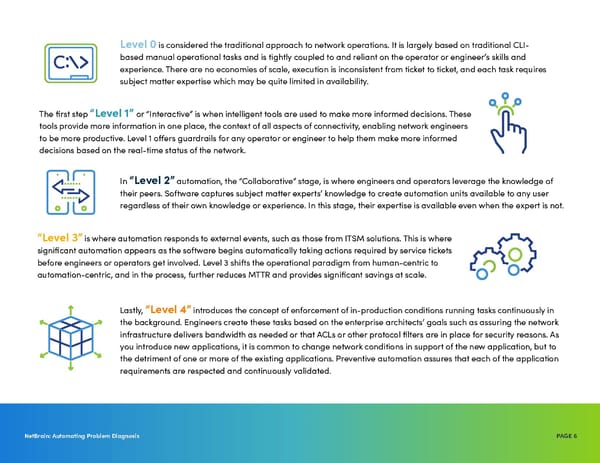PAGE 6 NetBrain: Automating Problem Diagnosis Level 0 is considered the traditional approach to network operations It is largely based on traditional CLI- based manual operational tasks and is tightly coupled to and reliant on the operator or engineer’s skills and experience There are no economies of scale, execution is inconsistent from ticket to ticket, and each task requires subject matter expertise which may be quite limited in availability The first step “Level 1” or “Interactive” is when intelligent tools are used to make more informed decisions These tools provide more information in one place, the context of all aspects of connectivity, enabling network engineers to be more productive Level 1 offers guardrails for any operator or engineer to help them make more informed decisions based on the real-time status of the network In “Level 2” automation, the “Collaborative” stage, is where engineers and operators leverage the knowledge of their peers Software captures subject matter experts’ knowledge to create automation units available to any user regardless of their own knowledge or experience In this stage, their expertise is available even when the expert is not “Level 3” is where automation responds to external events, such as those from ITSM solutions This is where significant automation appears as the software begins automatically taking actions required by service tickets before engineers or operators get involved Level 3 shifts the operational paradigm from human-centric to automation-centric, and in the process, further reduces MTTR and provides significant savings at scale Lastly, “Level 4” introduces the concept of enforcement of in-production conditions running tasks continuously in the background Engineers create these tasks based on the enterprise architects’ goals such as assuring the network infrastructure delivers bandwidth as needed or that ACLs or other protocol filters are in place for security reasons As you introduce new applications, it is common to change network conditions in support of the new application, but to the detriment of one or more of the existing applications Preventive automation assures that each of the application requirements are respected and continuously validated
 Problem Diagnosis Automation eBook Page 5 Page 7
Problem Diagnosis Automation eBook Page 5 Page 7